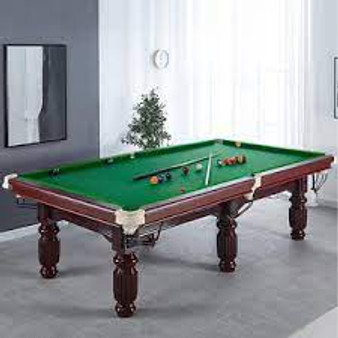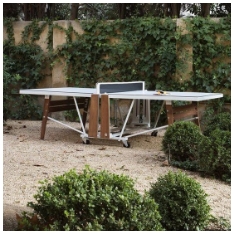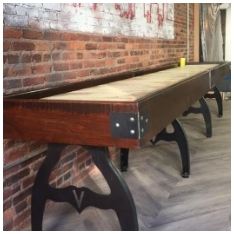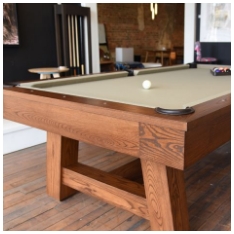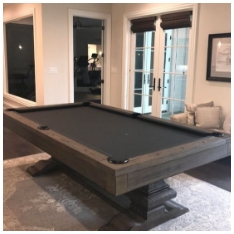Owning a pool table is a great addition to any home, but proper setup is essential for a smooth and enjoyable game. One of the most important aspects of pool table maintenance is ensuring it is perfectly level. An uneven table can lead to inaccurate shots, frustrating gameplay, and uneven wear on the table felt. This guide will walk you through how to level a pool table step by step, ensuring you get the best playing experience.
Why Leveling Your Pool Table Matters
A pool table that isn’t level affects more than just the quality of your shots. Here’s why leveling is crucial:
- Fair Gameplay: Balls roll accurately on a level surface, making games fair and competitive.
- Prevent Damage: Uneven tables can strain the frame and legs, causing long-term damage.
- Consistency: Regular leveling ensures that the table remains in peak condition, providing consistent gameplay every time.
Understanding the importance of leveling is the first step in taking care of your table. Whether your pool table is new or has been moved recently, checking its level is essential.
Tools You Will Need
Before learning how to level a pool table, gather the necessary tools:
- A bubble level or laser level
- Adjustable wrenches or screwdrivers (depending on your table’s construction)
- Shims (thin pieces of wood or metal to adjust height)
- Measuring tape
Having the right tools ensures you can make precise adjustments without damaging the table.

Step-by-Step Guide: How to Level a Pool Table
Follow these steps carefully to level your pool table accurately.
Step 1: Check the Table's Current Level
Start by placing the bubble level in several positions on the table:
- Across the length
- Across the width
- Diagonally from corner to corner
This will help you identify which areas are higher or lower. Note where adjustments are needed.
Step 2: Adjust the Legs
Most modern pool tables have adjustable legs. Here’s how to adjust them:
- Loosen the bolts on the leg slightly.
- Turn the leg clockwise to raise or counterclockwise to lower.
- Recheck the level using the bubble level.
If your table has fixed legs, you will need to use shims to correct the height differences.
Step 3: Use Shims for Fine-Tuning
Shims are thin wedges that help raise a lower side without major structural changes. To use them:
- Place shims under the legs that need raising.
- Recheck the level after each adjustment.
- Ensure the shims are secure and won’t slip during play.
Shims allow for precise leveling and are especially useful for tables on uneven floors.
Step 4: Recheck the Level
Once the initial adjustments are made, check the table again in all directions:
- Lengthwise
- Widthwise
- Diagonal
Repeat the adjustment process until the table is perfectly level in every direction. Precision is key here, as even a small tilt can affect gameplay.
Step 5: Secure the Table
After leveling, tighten all bolts and screws to ensure stability. Make sure the table legs are firmly anchored and shims are properly seated. This prevents movement and maintains the table’s level over time.
Tips for Maintaining a Level Pool Table
Leveling your table once is not always enough. Over time, floors settle, and tables can shift. Here are tips to maintain a level surface:
- Check Regularly: Inspect the level every few months, especially if the table is frequently used.
- Avoid Heavy Objects: Do not place heavy furniture or items on the table, as this can cause uneven pressure.
- Move Carefully: If relocating the table, recheck the level immediately after setup.
Following these maintenance tips ensures your pool table stays in top condition and provides consistent gameplay.
Common Mistakes to Avoid
When learning how to level a pool table, avoid these mistakes:
- Skipping Diagonal Checks: Always check diagonal leveling in addition to length and width.
- Over-tightening Legs: Tightening too much can strain the table frame.
- Ignoring Floor Irregularities: Sometimes the floor itself is uneven; use shims accordingly.
Avoiding these errors will save you time and prevent damage to your pool table.
Conclusion
Knowing how to level a pool table is essential for anyone who wants a perfect game every time. Proper leveling ensures fair gameplay, protects your table, and extends its lifespan. By following the steps outlined in this guide, using the right tools, and performing regular maintenance, you can enjoy a balanced and accurate pool experience for years to come.
A level table is the foundation of quality play. Take the time to check, adjust, and secure your table, and you’ll notice the difference in your game immediately.
